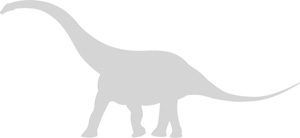Every month, 100,000 readers use the Dinosaur Database, but we receive no support from you. Developing and updating the database requires a lot of work. If you want it to remain open and be updated, please support us via the "Buy us a coffee" button available on every page or via the Support page.
Dinosaur: Xingxiulong yueorum

| Length*: | 9.8 m | 32.2 ft |
| Weight*: | 3 t | 6,614 lb |
*The largest known specimen
Period
Epoch: Early Jurassic
Stage: Hettangian
Years: 201.4–199.3 Ma
Details
Status: valid
Author: Chen et al.
Year: 2025
Distribution
Area: Asia
Country: China
Region: Yunnan
Formation: Lower Lufeng
Description
Xingxiulong yueorum
Xingxiulong yueorum was an early-diverging sauropodomorph dinosaur that lived during the Early Jurassic period, approximately 200 million years ago. It was discovered in the Lufeng Formation of Yunnan Province, China. This species is a newly described member of the genus Xingxiulong, which was first established in 2017. The species name honors the Yue family, who contributed to the collection and preservation of fossils from the Lufeng Formation.
Physical Characteristics
Xingxiulong yueorum was a relatively large non-sauropodan sauropodomorph, estimated to reach 8–10 meters (26–33 ft) in length. It exhibited a mix of primitive and derived features, shedding light on the transition from bipedal early sauropodomorphs to quadrupedal sauropods.
Key skeletal features include:
- Four sacral vertebrae, a trait typically associated with later sauropods.
- Pendant-shaped fourth trochanter on the femur, with a distinct distal termination.
- Straight dorsal margin on the posterior surface of the astragalus, differing from other sauropodomorphs.
- Two phalanges on pedal digit V, a rare condition in non-sauropodan sauropodomorphs.
- Robust scapula, with both proximal and distal ends being extremely expanded.
- Ilium with a strongly concave ventral margin of the postacetabular process, distinguishing it from Xingxiulong chengi.
These characteristics indicate that Xingxiulong yueorum may have been more adapted for quadrupedal locomotion than some of its relatives, representing a key transitional form in early sauropodomorph evolution.
Diet and Feeding Habits
Like other basal sauropodomorphs, Xingxiulong yueorum was a herbivore, feeding on ferns, cycads, and conifers that thrived in the Early Jurassic. Its long neck and powerful limbs suggest it may have browsed at various heights, similar to later sauropods. While no direct evidence of gastroliths has been found, other sauropodomorphs are known to have used stomach stones to aid in digestion.
Habitat and Distribution
Xingxiulong yueorum lived in what is now southwestern China, specifically in the Lufeng Basin of Yunnan Province. The Lufeng Formation represents an ancient floodplain environment with a mix of river channels, lakes, and seasonal wetlands. This region was home to a diverse array of early dinosaurs, including other sauropodomorphs like Lufengosaurus and Yunnanosaurus, suggesting that Xingxiulong coexisted with multiple related species in a rich Jurassic ecosystem.
Behavior and Social Structure
There is no direct evidence of herding behavior in Xingxiulong yueorum, but its close relatives are thought to have lived in groups. Its strong limbs and large size suggest that it was well-adapted for either facultative quadrupedalism or obligate quadrupedalism. Some researchers propose that early sauropodomorphs like Xingxiulong gradually shifted from bipedal to quadrupedal locomotion as they increased in size.
Discovery and Research
The holotype specimen (LF2015-NO01) was discovered in Erzuanshan, about 10 km north of Lufeng City, in Yunnan Province, China. It consists of a nearly complete postcranial skeleton, still partially embedded in matrix. The fossil was described in 2025 by Xiang-Yuan Chen, Ya-Ming Wang, Qian-Nan Zhang, Tao Wang, and Hai-Lu You in Historical Biology. Phylogenetic analysis places Xingxiulong yueorum as the sister species to Xingxiulong chengi, further supporting the diversity of early sauropodomorphs in the Lufeng Formation.
Significance and Interesting Facts
- Xingxiulong yueorum had four sacral vertebrae, a feature more commonly associated with later sauropods.
- It was likely one of the largest early sauropodomorphs, with an estimated length of 8–10 meters.
- It represents a key transitional form between smaller, bipedal early sauropodomorphs and later, quadrupedal sauropods.
- Its strong limbs and pelvic adaptations suggest it may have walked on all fours, unlike earlier relatives.
- It was found in the Lufeng Basin, one of the most important fossil sites for early Jurassic dinosaurs
Locations
Sources
Material: 13 dorsal vertebrae, 11 paired dorsal ribs, four sacral vertebrae, 20 caudal vertebrae, 20 chevrons, partial left scapula, complete pelvic girdles, complete hindlimbs
References: Chen, X. -Y., Wang, M. -Y., Zhang, Q. -N., Wang, T., & You, H. -L. (2025). "A new species of Xingxiulong (Dinosauria, Sauropodomorpha) from the lower Jurassic Lufeng formation of Yunnan Province, China". Historical Biology, 1-10



